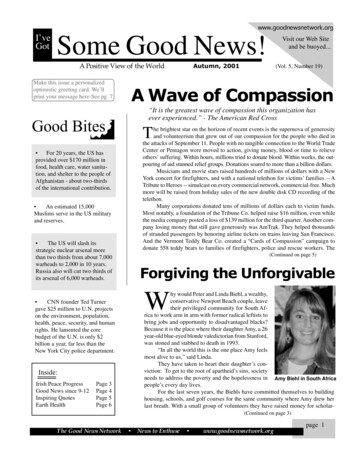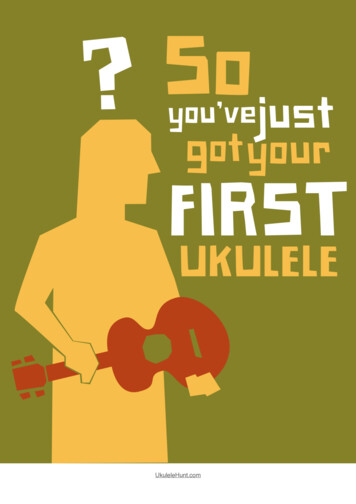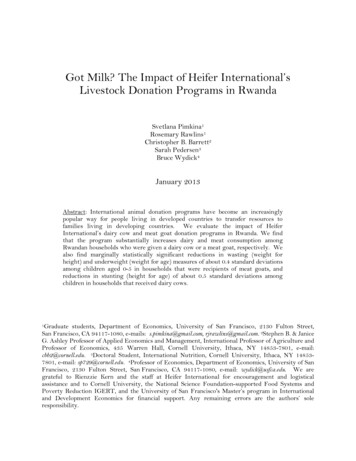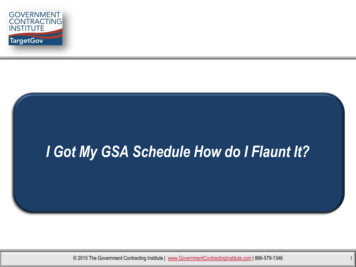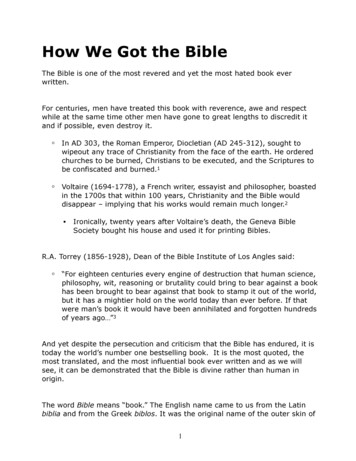
Transcription
How We Got the BibleThe Bible is one of the most revered and yet the most hated book everwritten.For centuries, men have treated this book with reverence, awe and respectwhile at the same time other men have gone to great lengths to discredit itand if possible, even destroy it. In AD 303, the Roman Emperor, Diocletian (AD 245-312), sought towipeout any trace of Christianity from the face of the earth. He orderedchurches to be burned, Christians to be executed, and the Scriptures tobe confiscated and burned.1 Voltaire (1694-1778), a French writer, essayist and philosopher, boastedin the 1700s that within 100 years, Christianity and the Bible woulddisappear – implying that his works would remain much longer.2 Ironically, twenty years after Voltaire’s death, the Geneva BibleSociety bought his house and used it for printing Bibles.R.A. Torrey (1856-1928), Dean of the Bible Institute of Los Angles said: “For eighteen centuries every engine of destruction that human science,philosophy, wit, reasoning or brutality could bring to bear against a bookhas been brought to bear against that book to stamp it out of the world,but it has a mightier hold on the world today than ever before. If thatwere man’s book it would have been annihilated and forgotten hundredsof years ago ”3And yet despite the persecution and criticism that the Bible has endured, it istoday the world’s number one bestselling book. It is the most quoted, themost translated, and the most influential book ever written and as we willsee, it can be demonstrated that the Bible is divine rather than human inorigin.The word Bible means “book.” The English name came to us from the Latinbiblia and from the Greek biblos. It was the original name of the outer skin of!1
the papyrus reed that people used to write upon in antiquity times andaround the second century AD, the word was used by Christians to describetheir sacred writings.The Bible is made up of 66 separate books and letters, 39 Old Testament and27 New Testament.These two major parts, the Old Testament and the New Testament, couldbetter be called covenants since they are taken from the Hebrew and Greekwords that mean “a compact or agreement between two parties.”The Old Testament or Covenant is what is referred to as a Suzerain-Vassalcovenant. This is when a great king [a suzerain] ruled over and demandedloyalty from a subject king [a vassal] and an example of this “conditional”covenant is the Mosaic or Sinaitic Covenant as seen in the following verse: Exodus 19:5 says, “Now if you obey me fully and keep my covenant,then out of all the nations you will be my treasured possession.”The New Testament or Covenant is what is referred to as a Royal Grantcovenant. An example is when love and forgiveness is offered unconditionallyto a subject or heir as seen in the following verses: Jeremiah 31:31-34 says, “‘Behold, the days are coming,’ says the LORD,‘when I will make a new covenant with the house of Israel and with thehouse of Judah – not according to the covenant I made with theirfathers For I will forgive their iniquity, and their sin I will remember nomore.’”It’s important to remember that for there to be a testament or covenant,something or someone has to die to cover our sins. Hebrews 9:16-17 says, “For where there is a testament, there must alsoof necessity be the death of the testator. For a testament is in forceafter men are dead, since it has no power at all while the testator lives.” The Old Testament was validated with the death and blood ofsacrificial animals.!2
The New Testament was validated with the death and blood of JesusChrist, the Son of God.This is one reason why “The Book of Mormon – Another Testament of JesusChrist” is invalid. Who died for it? Someone has to die for it to be valid.The Bible was written across a time span of approximately 1,600 years, bymore than 40 different people with varying educations, backgrounds andoccupations. For example: David was a king.Moses and Hosea were shepherds.Joshua was a military general.Isaiah, Ezekiel and Jeremiah were prophets.Daniel was a prime minister.Luke was a doctor.Peter and John were fishermen.The Bible was written on three different continents, Africa, Asia and Europe inthree different languages, Hebrew, Greek and Aramaic.Yet, in spite of the diversity of the people writing over a span of 1,600 yearsfrom different cultures, occupations, continents and languages, the Bible hasone consistent message applicable not only for the time in which it waswritten but also for today.Imagine if we were to look at a Medical Dictionary that spanned just 500years over three continents and written by 40 different individuals; thevariations we would find would be enormous. In Africa, we might read ofwitch doctors using spells to relieve pain, in Europe we might read of leachesand blood lettings to relieve the same symptoms while somewhere else,surgery would be the required medical procedure.My point is this, the Bible is the Word of God, it is consistent and withoutcontradictions and the original autographs are essentially the same today, aswe will see, as when they were written by the original authors.!3
What the Bible is AboutThe Bible has one consistent message from Genesis to Revelation and that isGod’s message of love, grace, mercy, salvation and redemption in the personof His Son, Jesus Christ. Jesus Christ testified that He is the theme of the Bible in John 5:39,46-47 – “You search the Scriptures, for in them you think you haveeternal life; and these are they which testify of Me For if you believedMoses, you would believe Me; for he wrote about Me. But if you do notbelieve his writings, how will you believe My words?” In Luke 24:27, Jesus says, “And beginning at Moses and all theProphets, He expounded to them in all the Scriptures the thingsconcerning Himself.” And in Luke 24:44, Jesus “said to them, ‘These are the words which Ispoke to you while I was still with you, that all things must be fulfilledwhich were written in the Law of Moses and the Prophets and thePsalms concerning Me.’” In Matthew 5:17 Jesus says, “Do not think that I came to destroy theLaw or the Prophets. I did not come to destroy but to fulfill.” And again in Hebrews 10:7, Jesus affirmed Himself to be the theme ofthe Old Testament, “Then I said, ‘Behold I have come – In the volume ofthe book it is written of Me – to do Your will, O God.’”As Josh McDowell explains:4 The Old Testament is the preparation (Isaiah 40:3) The Gospels are the manifestation (John 1:29) The Book of Acts is the propagation (Acts 1:8) The Epistles give the explanation (Colossians 1:27) And the Book of Revelation is the consummation (Revelation 1:7)!4
The Bible is all about Jesus. The Old Testament points forward to Jesus andthe New Testament is about Jesus. The Bible is His-story.The Bible – Inspired Word of GodIn 2 Timothy 3:16-17 we read, “All scripture is given by inspiration of God,and is profitable for doctrine, for reproof, for correction, for instruction inrighteousness, that the man of God may be complete, thoroughly equippedfor every good work.” by inspiration of God [Greek: theopneustos] literally means breathedout by God or simply God-breathed. profitable for doctrine – This means that all scripture is profitable forknowing what is right. profitable for reproof – This means that all scripture is profitable forknowing what is wrong. profitable for correction – This means that all scripture is profitable inhow to get right. profitable for instruction – This means that all scripture is profitable inhow to stay right.Also, the Bible was given once.Jude 1:3 tells us, “I found it necessary to write to you exhorting you tocontend earnestly for the faith which was once for all delivered to the saints.” Notice the “definite article” (i.e., the) in front of the word faith. Itmeans the “one and only faith.” The word once [Greek: hapax] means “one (or a single) time.”Old Testament Inspiration!5
We can see two methods of determining that the Old Testament is theinspired word of God.1. Old Testament claims of Inspiration.2. Old Testament claims of Inspiration found in the New Testament.First, Old Testament claims of inspiration begin with the prophet of God whowas the mouthpiece of God. He was the one who declared what God haddisclosed to Him.We can see various descriptions of a prophet of God in the following verseswhen he’s called “man of God” (1 Kings 12:22)“servant” (1 Kings 14:18)“messenger” (Isaiah 42:19)“seer” (Isaiah 30:10)“spiritual man” (Hosea 9:7)“watchman” (Ezekiel 3:17)And these men of God wrote down what God had told them: Exodus 24:4 says that Moses “wrote all the words of the LORD.” Deuteronomy 31:24-26 says that Moses’ Law was written in a book. Joshua 1:8 says, “This Book of the Law shall not depart from yourmouth.” Joshua 24:26 says that he also “wrote in the Book of the Law of God.” Jeremiah 36:28 says to “take another scroll and write on it all theformer words that were in the first scroll.” In Isaiah 8:1, he was commanded to “Take a large tablet and writeupon it” God told Habakkuk, “Write the vision; make it plain upon tablets, so hemay run who reads it.”!6
All the traditional authors of the Old Testament are designated prophet byeither title or function.5And thus, around 2,000 times we read of the men of God stating, “God said ”or “Thus says the LORD ”Second, New Testament Claims of Inspiration of the Old Testament asdetermined by Jesus and the apostles referring to and quoting from the OldTestament.Remember, Jesus was Jewish and when He refers to the Scriptures, He’sreferring to the Old Testament.Jesus claimed Scripture as His authority for cleansing the temple (Mark 11:17) rebuking the tradition of the Pharisees (Matthew 15:3, 4) settling doctrinal disputes (Matthew 22:29) and in Matthew 4:4, 7, 10 Jesus rebuked the devil 3 times byresponding, “It is written.It is written It is written” Jesus said in John 10:35, “The Scripture cannot be broken.” Jesus also said that, “Everything written must be fulfilled” in Luke24:44. He also said that, “It is easier for heaven and earth to pass away thanfor one dot of the law to become void” in Luke 16:17.Jesus often spoke on the authority that the Old Testament was inspired andgives final authority on all matters.For example:6!7
Jesus refers to Scripture as an authority 56 times. Jesus quotes directly from Scripture, implying even that specific wordsare from God, more than 81 times.Not only can we see that Jesus knew Scripture was authoritative but we canalso see the inspiration of The whole Old Testament: The apostle Paul “reasoned with them from the Scriptures” (Acts17:2). Paul also “vigorously refuted showing from the Scriptures that Jesusis the Christ” (Acts 18:28). The Bereans “searched the Scriptures daily” (Acts 17:11). John 10:35 uses the “the word of God” as a synonym for theScriptures.The sections of the Old Testament: The Law (the first five books of the O.T.) is referred to in Matthew12:5; Acts 13:39; Hebrews 10:28. The Prophets (the second half of the O.T.) is referred to in John1:45; Luke 18:31; Matthew 26:56 and Acts 7:42. The Writings (Jesus refers to “The law of Moses, and the prophets,and the psalms.”) in Luke 24:44.And specific books of the Old Testament: 18 of the 22 books in the Jewish canon are cited as authoritative inthe New Testament with the rest having references or referentialsupport in the New Testament.!8
New Testament InspirationAs Norman Geisler and William Nix explain New Testament inspiration:“The apostles and prophets of the New Testament did not hesitate toclassify their writings as inspired along with the Old Testament. Theirbooks were revered, collected, and circulated in the early church assacred scripture. What Jesus claimed about the Old Testamentinspiration He also promised His disciples for the New [Testament].”7There are two basic claims of inspiration regarding the New Testament:1. Jesus’ promise that He would guide the apostles by His Holy Spirit intoremembrance and teaching truth to establish His church.2. The fulfillment of Jesus’ promises by the writing of the New Testament. Christ’s Promise About Inspiration – He gave the Holy Spirit: When sending out the twelve in Matthew 10:19-20, Jesus says, “Forwhat you are to say will be given to you in that hour; for it is not youwho speak, but the Spirit of your Father speaking throughyou.” (emphasis added) When predicting the temples destruction in Mark 13:11, Jesusreaffirmed, “But say whatever is given you in that hour, for it is notyou who speak, but the Holy Spirit.” (emphasis added) In John 14:26, Jesus told his disciples, “But the Counselor, the HolySpirit, whom the Father will send in My name, He will teach you allthings, and bring to remembrance all that I have said to you.” In Matthew 28:19-20 Jesus commissioned His disciples to “makedisciples of all nations teaching them to observe all I havecommanded you.” (emphasis added)Again, Jesus promised that the apostle’s teachings would be truth filled andSpirit lead.!9
Continued Claims of Christ’s Teachings after Jesus: In Acts 1:1, Luke says that he recorded the things that “Jesus beganto both do and to teach.” And that these were accurate accounts inLuke 1:3-4. In fact, the early church was characterized by “the apostle’steachings” in Acts 2:42. Even Paul says his teachings are based on revelation from God: Galatians 1:11-12 says, “But I make known to you, brethren, thatthe gospel which was preached by me is not according to man but it came through the revelation of Jesus Christ.” Ephesians 2:20; 3:5 says that the New Testament church was “builton the foundation of the apostles and prophets, Jesus Christ Himselfbeing the chief cornerstone as it has now been revealed by the Spiritto His holy apostles and prophets.” In 2 Peter 3:16, Peter classes Paul’s other epistles along with “therest of the Scriptures.” In 1 Timothy 5:18, Paul quotes Luke’s gospel (Luke 10:7) calling it“Scripture.” Paul gives his own writings equal authority with “Scripture.” 1 Timothy 4:11, 13 says, “These things [speaking of the things hejust taught] command and teach give attention to reading, toexhortation, to doctrine.” In Titus, Paul exhorts to “Speak these things, exhort, and rebukewith all authority.” Revelation 1:1 states, “The Revelation of Jesus Christ, which Godgave” In fact, no book claims to have divine inspiration more thanRevelation with the warning not to tamper with its contents orelse face divine judgment (Revelation 22:18, 19).!10
When you work your way through the New Testament, it becomes clear thatthe books claim apostleship, inspiration and that they’re authoritative andthey have explicit claims of divine authorship.In summary, the Bible is the Word of God, it’s inspired or literally Godbreathed and Jesus and the New Testament authors often quoted from theOld Testament.And since it’s God-breathed, here’s what the Bible claims about itself:Psalm 19:7-9 says, “The law of the LORD is perfect, converting the soul; Thetestimony of the LORD is sure, making wise the simple; The statutes of theLORD are right, rejoicing the heart; The commandment of the LORD is pure,enlightening the eyes; The fear of the LORD is clean, enduring forever; Thejudgments of the LORD are true and righteous altogether.”Where Did We Get the Bible?When we speak of the canon of Scripture, what are we talking about?Canon comes from the Greek word kanon and means “a rod or ruler” which inturn comes from the Hebrew word kaneh meaning “a measuring rod” andover time came to mean the books that were “measured” and recognized asGod’s inspired Word.Today, when someone says canon of Scripture, they mean that body ofScripture that is accepted as authoritative.It’s important to note that canonicity is determined by God. A book is notinspired because man made it canonical, it’s canonical because God inspired itand man discovered it.In other words, “It is God who regulated the canon; man merely recognizedthe divine authority God gave to it.”8Tests for Canonicity are as follows:9!11
1. Was the book written or backed by a prophet or apostle of God?2. Is the book authoritative?3. Does the book tell the truth about God and doctrine as it is alreadyknown by previous revelation?4. Does the book give evidence of having the power of God?5. Was the book accepted by the people of God?The Old TestamentFrom the time they were composed to present, the books of the OldTestament have always been considered holy to the Jewish people.We are told in the Bible that it was the responsibility of the priests of Israel,the Levites, to ensure the preservation of the Law. They were to place it in oralong side the Ark of the Covenant in the Holy of Holies in the tabernacle. Deuteronomy 31:26 says, “Take this Book of the Law, and put it besidethe ark of the covenant of the LORD your God, that it may be there as awitness against you.” After Moses placed his books there, Joshua added his to the collection inJoshua 24:26. Samuel added his writings to the collection when “[he] wrote it in abook and laid it up before the LORD” in 1 Samuel 10:25. David’s story was recorded in the “book of Samuel the seer” in 1Chronicles 29:29.These writings were considered so holy by the Jewish people that the Kings ofIsrael were required to write out an entire copy during their reign. Deuteronomy 17:18-19a says, “Also it shall be, when [the King] sits onthe throne of his kingdom, that he shall write for himself a copy of thislaw in a book, from the one before the priests, the Levites. And it shallbe with him, and he shall read it all the days of his life”!12
Since these early writings were considered holy to the Jewish people, theywere preserved with the most cautious care imaginable.The Mishnah, compiled around AD 200, is a written record of Jewish traditionfrom around Exodus and the time Moses to around AD 100. Here’s what theMishnah says:“Moses received the Law from Sinai and committed it to Joshua andJoshua to the elders, and the elders to the Prophets, and the Prophetscommitted it to the men of the Great Synagogue. They said threethings; be deliberate in judgment, gather up many disciples, and makea fence around the Law.”10The Mishnah also informs us that from the completion of the Old Testamentaround 400 BC, until around AD 500, the care of the Old Testament was inthe hands of a group of scribes called the Sopherim (“counters”).11These scribes were so meticulous that they counted every letter and everyword of the completed text that they were copying to the original just toensure that they had not missed anything.It cannot be over emphasized how extremely careful the scribes were incopying the text because they recognized they were handling the Word ofGod. For example we read:“Numerous examples can be cited to show the passion of scribes forminute details of the text. When for some reason a manuscript has aletter too large or too small, these letters of unusual size were carefullyduplicated. If, for example, a scribe found an extra letter in a word, hewould leave the word the same but put a dot above the letter or wordthat he questioned. The dots show the scribal uncertainty about a wordor letter, but the scribes did not alter the text because it was regardedas unalterable.” 12 (emphasis added)A group called the Massoretes (“tradition”) eventually succeeded theSopherim from about AD 500 to AD 900.!13
The Massoretes are probably best known for their vowel and accent systemdevised for the Hebrew language, since Hebrew is written without vowels.Eventually, in order to preserve the language when Hebrew was no longerspoken, the Massoretes devised a way of inserting vowel points above andbelow the lines of text without altering the original text itself and thus, theyonly added a means to ensure correct pronunciation of the text.Like the Sopherim, the Massoretes were careful not to change the originaltext. For example we read:“the Massoretes collected all the textual-critical remarks of the rabbis,all the additional marks added in the margins of the sacred texts (whichinclude memory devices, and pronunciation aids), and entered these inthe side margins of the copies they made. They also did extensivetabulations concerning the contents of the text which were added to theupper and lower margins of the page. These specialists considered thetext so holy that they never altered it even when the text they werecopying contained an obvious error. In such an instance, the procedurewas to enter the error into the text they were producing and then enterremarks in the margin concerning how it could be corrected.” 13(emphasis added)This system of Massorete notation is called the Kethiv-Qere or “what iswritten – what is read” and it enabled the scribes to place in the margins ofthe text what they thought was the correct (or original) spelling or renderingwhile not making any changes to the text itself.The observations in the margins were an intense zeal and desire to notchange the text and thus safeguard the accurate transmission of the textsinvolved.Below are rules that are listed in the Talmud for copying the HebrewScriptures similar to those of the Massoretes.“An authentic copy must be the exemplar, from which the transcriberought not in the least deviate. No word or letter, not even a yod (avowel mark), must be written from memory, the scribe not having!14
looked at the codex before him Between every consonant the space ofa hair or thread must intervene; between every word, the breadth of anarrow consonant; between every new section, the breadth of nineconsonants; between every book, three lines. The fifth book of Mosesmust terminate exactly with a line, but the rest need not do so. Besidesthis, the copyist must sit in full Jewish dress, wash his whole body, notbegin to write the name of God with a pen newly dipped in ink, andshould a king address him while writing that name he must take nonotice of him The rolls in which these regulations are not observed arecondemned to be buried in the ground or burned; or they are banishedto the schools, to be used as reading books.” 14Evidence shows the Hebrews accepted the current Old Testament books asScripture as early as 400 BC and no later than 167 BC. The books werechosen because of their recognition by the Jews as being divine, authoritativeand marked with inspiration.Altogether, Jesus and the apostles refer to Old Testament Scriptureauthoritatively nearly 300 times in the New Testament.The Dead Sea ScrollsEven though the work of the Sopherim and the Massoretes was extremelyimportant in the complete and correct transmission of the Old Testament, theoldest copy of the Old Testament that we had was from around AD 1000which was a full 1,400 years after the last Old Testament book was written.That is until the discovery, in 1947, by a young Bedouin shepherd in the cavesout in the desert at a site known as Qumran which is about a mile southwestof the northwest corner of the Dead Sea.What was discovered in those caves would later be called by the late Dr. W.F.Albright, one of the world’s leading archaeologists:“the most important Old Testament manuscript discovery ever made.”15!15
What was found in the two foot jars were a collection of 931 documents thathave come to be called the Dead Sea Scrolls. This collection contained theoldest known copies of the Old Testament made between 125 BC and AD 68.In those jars, they found: Every Old Testament book (except Esther)Commentaries on the Old TestamentExtra biblical worksSecular documents and business recordsThey were left in the caves by a Jewish Sect similar to the Pharisees andSadducees called the “Essenes” around AD 68, just prior to the fall ofJerusalem.The Dead Sea Scrolls prove the accuracy and care of the transmission of theOld Testament through the centuries by the scribes and keepers of the Law.Before the discovery of the Dead Sea Scrolls, the earliest known copy of theBook of Isaiah was the Masoretic Text of Isaiah dated around AD 916.When these two copies, the Masoretic copy and the Dead Sea copy, onethousand years apart were compared, what was found was the amazingaccuracy of the copyists at their task. For example we read:“Of the 166 words in Isaiah 53, there are only seventeen letters inquestion. Ten of these letters are simply a matter of spelling, which doesnot affect the sense. Four more letters are minor stylistic changes, suchas conjunctions. The remaining three letters comprise the word “light,”which is added in verse 11, and does not affect the meaning greatly.Furthermore, this word is supported by the LXX [Septuagint – anancient translation of the Old Testament into Greek] and IQ Is (one ofthe Isaiah scrolls found in the Dead Sea caves). Thus, in one chapter of166 words, there is only one word (three letters) in question after athousand years of transmission – and this word does not significantlychange the meaning of the passage.”16!16
In other words, the copies of Isaiah proved to be identical in more than 95percent of the text with the 5 percent variation consisting of obvious slips ofthe pen, variations in style and spelling but not substance.The New TestamentThe New Testament was written in the common Greek “street” language ofthe day called Koine Greek.Although we do not posses the original “autographs”, just as with the OldTestament, we can be assured that the New Testament we have today is thesame as what was written 2000 years ago by looking at the evidence toreconstruct the originals by using: The Greek Manuscripts - A manuscript is simply a hand written copy ofan ancient document that predates the invention of the printing press inAD 1455. The Versions or Translations – A manuscript that has been translatedinto a different language. The Writings of the Early Church Fathers – Sermons, commentaries andcorrespondences show the accuracy of today’s New Testament whencompared to their writings.The Greek ManuscriptsAs we will see, getting back to the original “autographs” is not an issuebecause of the abundance of manuscripts that we can use to reconstructthe original texts. We can confidently get back to the original texts basedon five types of manuscript evidence. Uncial Manuscripts – These types of manuscripts, written betweenthe fourth and tenth centuries, consists of upper-case letters thatlook like the following example of John ΟΓΟΣ!17
Miniscule Manuscripts – These types of manuscripts, written from theninth to the sixteenth centuries, replaced the uncial type of writingbecause it was faster but not as carefully executed. Lectionary Manuscripts – Fragments and complete manuscripts datefrom around the sixth to the eighth centuries. These are Scripturelessons used by the Christians on Sundays and Holy Days. Papyri Manuscripts – This is what the original autographs werewritten on and these copies of fragments are very perishable andcontain some of the earliest manuscript evidence.Number of manuscripts we have available for reconstruction:Type of ManuscriptNumber 3Papyri118Total5,745 (to date)The Versions or TranslationsVersions or Translations are copies of the Greek Manuscripts into anotherlanguage. It was rare that ancient literature was copied into anotherlanguage. The New Testament was the exception to this rule. This wasbecause early missionaries would translate them into languages of thepeople they would encounter.We have an overwhelming amount of fragment and manuscript evidence inwhich we can utilize to get back to the original “autographs” that werewritten.VersionsNumber of Manuscripts18Latin Vulgate10,000 (possibly 25,000)!18
Ethiopic2,000 Slavic4,101 Armenian2,587 Syriac Peshitta350 (possibly thousands moreuncatolged)Coptic (Bohairic & Sahidic)Approx. 1,000 although not all havebeen catalogedTotal20,000 Compare this to other ancient works:Author (Work)DateWrittenEarliestCopyTime Span(Years)Number ofCopies19Caesar (Gallic Wars) 100-44 BCAD 900100010Euripides450 BCAD 100015009Sophocles450 BCAD 10001400193Catullus54 BCAD 155015503Homer (Iliad)900 BC400 BC500643N.T.AD 40-100AD 1255024,000 And yet you never hear of any corruption discussed in the works of Homerfor example. It’s not even a topic of debate.Biblical scholar F.F. Bruce (1910-1990) said, “If the New Testament were acollection of secular writings, their authenticity would generally beregarded as beyond all doubt.”20!19
The Writings of the Early Church FathersWhen we talk about the “church fathers”, we are talking about the earlyleaders in the church around the first two centuries AD that followed theoriginal disciples. In fact, some of the early church fathers were taught bythe original disciples. For example, Polycarp, was a disciple of the apostleJohn.Other church fathers include Justin Martyr, Tertullian, Eusebius andIrenaeus.In their writings and correspondence with other believers, these men overand over again quote from the New Testament Scriptures.In fact, the four Gospels alone are quoted by the church fathers, andothers, an astonishing 19,368 times 21 while the other New TestamentScriptures are quoted over 86,000 times. 22Charlie Campbell, Director of the Always Be Ready Apologetics Ministrysaid:“There are enough quotations from the early church fathers that even ifwe did not have a single manuscript copy of the Bible, scholars couldstill reconstruct 99.86% of the New Testament that we have today.There were only 11 verses in the New Testament that were neverquoted by the Church Fathers.”The overall amount of citations from the New Testament in the sermons,commentaries, and correspondence of the church fathers as early as thefirst century AD and as late as the thirteenth century exceeds one million.23While most New Testament books were accepted as Scripture at least bythe early 2
in the 1700s that within 100 years, Christianity and the Bible would disappear – implying that his works would remain much longer.2 Ironically, twenty years after Voltaire’s death, the Geneva Bible Society bought his house and used it for printing Bibles. R.A. Torrey (1856-1928), Dean of

